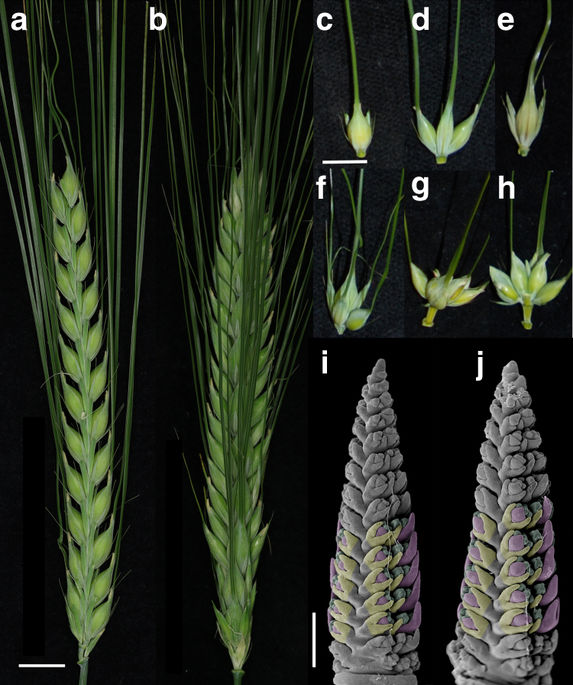当前位置:
X-MOL 学术
›
Nat. Commun.
›
论文详情
Our official English website, www.x-mol.net, welcomes your feedback! (Note: you will need to create a separate account there.)
Barley SIX-ROWED SPIKE3 encodes a putative Jumonji C-type H3K9me2/me3 demethylase that represses lateral spikelet fertility.
Nature Communications ( IF 14.7 ) Pub Date : 2017-10-16 , DOI: 10.1038/s41467-017-00940-7 Hazel Bull , M. Cristina Casao , Monika Zwirek , Andrew J. Flavell , William T. B. Thomas , Wenbin Guo , Runxuan Zhang , Paulo Rapazote-Flores , Stylianos Kyriakidis , Joanne Russell , Arnis Druka , Sarah M. McKim , Robbie Waugh
Nature Communications ( IF 14.7 ) Pub Date : 2017-10-16 , DOI: 10.1038/s41467-017-00940-7 Hazel Bull , M. Cristina Casao , Monika Zwirek , Andrew J. Flavell , William T. B. Thomas , Wenbin Guo , Runxuan Zhang , Paulo Rapazote-Flores , Stylianos Kyriakidis , Joanne Russell , Arnis Druka , Sarah M. McKim , Robbie Waugh

|
The barley inflorescence (spike) comprises a multi-noded central stalk (rachis) with tri-partite clusters of uni-floretted spikelets attached alternately along its length. Relative fertility of lateral spikelets within each cluster leads to spikes with two or six rows of grain, or an intermediate morphology. Understanding the mechanisms controlling this key developmental step could provide novel solutions to enhanced grain yield. Classical genetic studies identified five major SIX-ROWED SPIKE (VRS) genes, with four now known to encode transcription factors. Here we identify and characterise the remaining major VRS gene, VRS3, as encoding a putative Jumonji C-type H3K9me2/me3 demethylase, a regulator of chromatin state. Exploring the expression network modulated by VRS3 reveals specific interactions, both with other VRS genes and genes involved in stress, hormone and sugar metabolism. We show that combining a vrs3 mutant allele with natural six-rowed alleles of VRS1 and VRS5 leads to increased lateral grain size and greater grain uniformity.The VRS genes of barley control the fertility of the lateral spikelets on the barley inflorescence. Here, Bull et al. show that VRS3 encodes a putative Jumonji C-type histone demethylase that regulates expression of other VRS genes, and genes involved in stress, hormone and sugar metabolism.
中文翻译:

大麦六行SPIKE3编码一个推定的Jumonji C型H3K9me2 / me3脱甲基酶,该酶抑制侧生小穗的繁殖力。
大麦花序(穗)包括一个多结的中心茎(轴),其三部分簇的单花小穗沿其长度交替排列。每个群集内的侧小穗的相对肥力导致带有两行或六行谷粒或中间形态的穗。了解控制这一关键发展步骤的机制可以为提高谷物产量提供新颖的解决方案。古典遗传学研究确定了五个主要的六向钉状(VRS)基因,其中四个现在已知可编码转录因子。在这里,我们确定并表征剩余的主要VRS基因VRS3,以编码假定的Jumonji C型H3K9me2 / me3脱甲基酶(染色质状态的调节剂)进行编码。探索由VRS3调制的表达网络揭示了特定的相互作用,包括其他VRS基因和涉及压力,激素和糖代谢的基因。我们表明,将vrs3突变等位基因与VRS1和VRS5的天然六行等位基因结合会导致侧向晶粒尺寸增大和更大的颗粒均匀度。大麦的VRS基因控制着大麦花序侧向小穗的繁殖力。在这里,Bull等。结果表明,VRS3编码一个推测的Jumonji C型组蛋白脱甲基酶,该酶调节其他VRS基因以及与压力,激素和糖代谢有关的基因的表达。
更新日期:2017-10-16
中文翻译:

大麦六行SPIKE3编码一个推定的Jumonji C型H3K9me2 / me3脱甲基酶,该酶抑制侧生小穗的繁殖力。
大麦花序(穗)包括一个多结的中心茎(轴),其三部分簇的单花小穗沿其长度交替排列。每个群集内的侧小穗的相对肥力导致带有两行或六行谷粒或中间形态的穗。了解控制这一关键发展步骤的机制可以为提高谷物产量提供新颖的解决方案。古典遗传学研究确定了五个主要的六向钉状(VRS)基因,其中四个现在已知可编码转录因子。在这里,我们确定并表征剩余的主要VRS基因VRS3,以编码假定的Jumonji C型H3K9me2 / me3脱甲基酶(染色质状态的调节剂)进行编码。探索由VRS3调制的表达网络揭示了特定的相互作用,包括其他VRS基因和涉及压力,激素和糖代谢的基因。我们表明,将vrs3突变等位基因与VRS1和VRS5的天然六行等位基因结合会导致侧向晶粒尺寸增大和更大的颗粒均匀度。大麦的VRS基因控制着大麦花序侧向小穗的繁殖力。在这里,Bull等。结果表明,VRS3编码一个推测的Jumonji C型组蛋白脱甲基酶,该酶调节其他VRS基因以及与压力,激素和糖代谢有关的基因的表达。














































 京公网安备 11010802027423号
京公网安备 11010802027423号